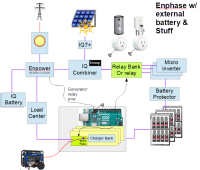svetz
Works in theory! Practice? That's something else
Occurred to me that for nighttime usage, for the cost of MC4 splitter cable ($7) and SPDT remote switch you could reuse an existing microinverter. That is have the existing microinverters hooked up to both the solar panel and the battery with a cutover switch to isolate them (e.g., microinverter can only ever be connected to one or the other). That essentially eliminates the microinverter costs. With the number of wireless switches and cable complexity it might not be worthwhile. Possibly replace the switch per panel with a diode to prevent backflow into the panel and use the main battery switch or relay bank?$720 - 12x iQ7+ @ $60 from eBay used
$ 10 - NodeMcu
$ 16 - 16-Channel Relay, 2 kW/channel
$280 - 4x 400W chargers
$3000 = At 30¢ Per Wh a 10 kWh battery is $3000, if you go cells and your own BMS 20¢/Wh + 55 - BMS = ~2100.
======
~$4,000 (or $3,000 with DIY cells)
+ 20% for breakers, wifi switches, wire
======
~$5,000
Last edited:




